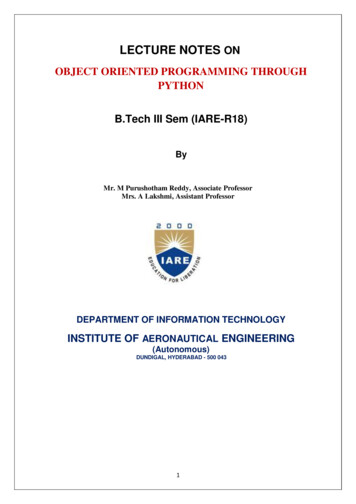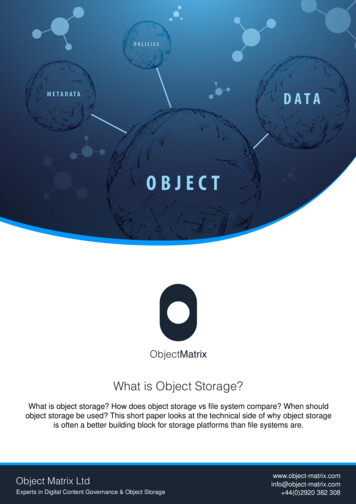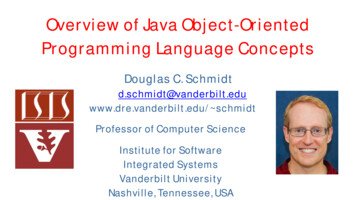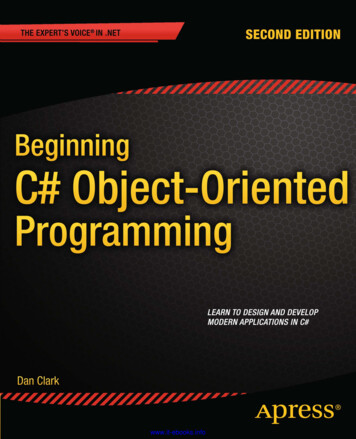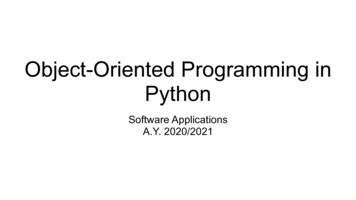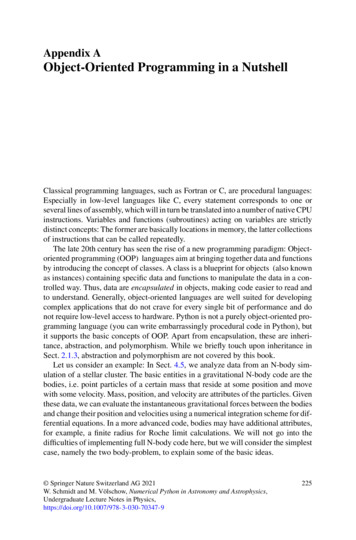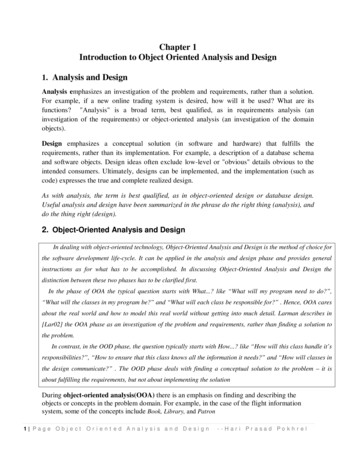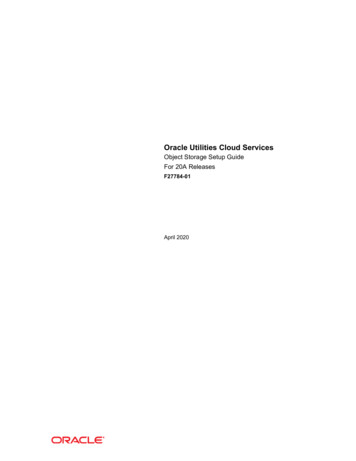
Transcription
Modular Object-Oriented Dynamic Learning Environment:What Open Source Has To OfferPavlo AntonenkoSerkan ToyDale NiederhauserIowa State UniversityOpen source online learning environments have emerged and developed over the past 10years. In this paper we will analyze the underlying philosophy and features of MOODLEbased on the theoretical framework developed by Hannafin and Land (2000).Psychological, pedagogical, technological, cultural, and pragmatic foundations comprisethe framework and represent the major points of our analysis. This paper is intended forinstructional designers, distance education specialists, K-12 and college instructors whomay want to add an online component to their courses.As we enjoy great Advantages from the Inventions of others weshould be glad of an Opportunity to serve others by any Invention ofours, and this we should do freely and generously. Benjamin FranklinIntroductionBenjamin Franklin’s philosophy resonates in the recent advent of open source software. The term “opensource” refers to computer programs or operating systems for which the source code is publicly available. (JohnsonEilola, 2002) The definition further explains that inherent in the open source philosophy is the freedom of adistributed community of programmers to modify and improve the code (Perens, 1999).Open source software promotes the use of technologically-neutral, non-proprietary tools and formats,which allow for wide-spread access. According to the Open Source Initiative website (2004), the major reasons forutilizing open source software include free distribution, freedom to modify the software to meet individual needs,cross-platform compatibility and universal accessibility, and active collaboration to improve design. These factorsbear a special significance in an educational setting. As Terry Vessels (2004) puts it: Educators have been called upon throughout history to combat censorship imposed by variouspowers over the flow of information. The censorship being applied today comes in the form oflicenses that lock away the tools to build the information age and laws that limit fair use in waysthat are unprecedented in the modern era (¶ 2).The open source movement has already had a significant impact in the business world (Wheeler, 2003), andis now drawing the attention of educators around the globe. Distance education is at the forefront of using andcreating open source applications in education.Current advances in open source online learning environments are a response to the shortcomings ofcommercial products like WebCT and Blackboard. One such weakness is a lack of flexibility in designing andadding customized learning modules. With commercial products one can only include elements that the softwaredesigners deemed necessary when they developed the program. With an open source learning environment it ispossible to download and use any learning module one might find on any open source software website. This opensalmost limitless capabilities for the user to customize the application by choosing from a variety of options for email, discussion boards, chat, online quizzes, and all the other elements one might want to include.Further, as the open source definition suggests, the actual code can be modified and improved to meetindividual needs. So, if the user decides that an open source module he or she found is almost perfect, the code canbe modified to meet his or her needs. Look, feel and functionality can all be changed since the code can be easilyaccessed and modified.As to pricing of commercial products, “companies are moving toward selling campuswide access tosoftware, and toward setting prices based on the number of students each college enrolls.” (Young, 2002) According1
to Young, “ the company's [WebCT] current software costs 3,000 to 30,000 annually, depending on the size ofthe institution and the level of use of the software.” This is particularly important with seemingly continualdecreases in federal and state appropriations for higher education. All open source software, on the other hand, isavailable free of charge to anyone who wants to use it.Shortcomings of commercial distance education software have prompted the development of a number ofopen source online learning environments such as MOODLE, EduCreate, Covidia, and LogiCampus. Concurrently,the open source concept has developed to the point that even the tools used to create such systems are open source.For example, most of this software is written in Hypertext Preprocessor (PHP) an open source alternative tocommercial scripting languages and make use of open source relational database systems like MySQL. They can beinstalled on almost any web server—the most popular being Apache (again, open source). One open source onlinelearning environment, Modular Object-Oriented Dynamic Learning Environment (MOODLE) is a highly usable,reliable, and functional alternative to popular commercial products like WebCT and Blackboard. Developed byMartin Dougiamas, a PhD student in Computer Science and Education at Curtin University of Technology,Australia, this learning environment provides the considerable flexibility inherent in open source software fordesigning and administering Web-based courses to meet the individual needs of online educators. It was specificallydeveloped to address the aforementioned shortcomings of commercial online learning environments—which he hadused and supported in his own teaching and as a technician working with faculty. In his own words: It started in the 90's when I was a webmaster at Curtin University of Technology and a systemadministrator of their WebCT installation. I encountered many frustrations with the WebCT beastand developed an itch that needed scratching – there had to be a better way (no, not Blackboard :)(Dougiamas, 2004, ¶ 2).Analysis of MOODLEDougiamas decided to create his own online learning environment in the open source format and allow theopen source community to help develop and refine his ideas. MOODLE was designed to support and promote usersinterested in developing constructivist, student-centered learning environments (Dougiamas, 2004). To examine thisclaim, we conducted an analysis of MOODLE using a framework developed by Land and Hannafin (2000) whichwas initially designed as a guide for developing constructivist learning environments. According to the authors,“Learning environments, directed as well as constructivist, are rooted in five core foundations: psychological,pedagogical, technological, cultural, and pragmatic” (Hannafin & Land, 1997). Figure 1 highlights the fivecomponents of these core foundations as applied to the design of student-centered learning environments.2
Figure 1: Five core foundations of student-centered learning environments (Hannafin & Land, 1997)In the remainder of the paper we will relate each of Hannafin and Land’s core foundations to theunderlying philosophy and principles that guided the development of MOODLE.Psychological FoundationsPsychological foundations address research, theory and practice associated with how people think andlearn. Our examination of the program shell and standard MOODLE learning modules reflect the designers’ use ofseveral important considerations from cognitive psychology:Situated cognition suggests effective learning should involve immersing students in authentic activity andculture in a real-world learning context. (Brown, Collins, & Duguid, 1989). Relevance is enhanced throughinterconnected, embedded engagement with interesting and complex tasks situated in an authentic context. Situatedlearning integrates four critical factors that maximize student learning potential: content, context, community, andparticipation (Stein, 1998). MOODLE learning modules allow instructors to set up complex, ill-defined andauthentic tasks in real-life contexts, and assign roles for students to assume in the solution of these problems. Forexample, the Workshop module allows students to collaborate on the design of possible solutions to an authenticproblem and peer assess the suggested solutions. The instructor might decide to have students work individually orin groups to determine where to build an alternate route to help alleviate traffic accidents at a specific intersection.In the Resource module the instructor can scaffold the activity by providing area maps, different perspectives on theproblem (e.g. interviews with Department of Transportation experts), and sample solutions devised by other states orcounties. Students can brainstorm possible solutions in Chat or Discussion forums, then present their alternate routes3
via the Workshop module, which allows for peer assessment. Thus, learners will compare and contrast theirsolutions and select the best one based on the group discussions.Cognitive flexibility is defined as “the ability to adaptively re-assemble diverse elements of knowledge tofit the particular needs of a given understanding or problem-solving situation” (Spiro & Jehng, 1990). This theoryfocuses on learning in complex and ill-structured domains—which represent many real-life situations. “A centralclaim of cognitive theory is that revisiting the same material, at different times, in rearranged contexts, for differentpurposes, and from different conceptual perspectives is essential for attaining the goals of advanced knowledgeacquisition” (Spiro, Feltovich, Jacobson, & Coulson, 1991). One of the major metaphors employed by the theory isthat of a “ criss-crossed landscape, with its suggestion of a non-linear and multi-dimensional traversal of complexsubject matter, returning to the same place in the conceptual landscape on different occasions, coming from differentdirections” (Spiro, Vispoel, Schmitz, Samarapungavan, & Boerger 1987; Wittgenstein, 1953). MOODLE supportsthe “criss-crossing of the conceptual landscape” through the Glossary learning module–a unique feature that allowsusers (both students and instructors) to create an online hypertext -based dictionary that is created on the fly andupdates automatically to all content in the course or even throughout the entire portal. This module allows users toconsult the glossary dynamically while navigating through the lesson content, assignments, or even discussionpostings, but, perhaps more importantly, students take ownership for their learning as they actively construct aricher, more complex and sophisticated learning environment.Pedagogical FoundationsPedagogical foundations include the instructional practices that the designers use. They are grounded intheories of learning and reflect the teaching strategies with which they are aligned. MOODLE developers haveexplicitly stated that the design of the software is grounded in constructivist and constructionist instructionalprinciples. In the following paragraph, Dougiamas (2004) discusses the importance of pedagogy and encourageseducators to adopt the constructivist methodology:Once you are thinking about all these [pedagogical] issues, it helps you to focuson the experiences that would be best for learning from the learner's point ofview, rather than just publishing and assessing the information you think theyneed to know. It can also help you realise how each participant in a course canbe a teacher as well as a learner. Your job as a 'teacher' can change from being'the source of knowledge' to being an influencer and role model of class culture,connecting with students in a personal way that addresses their own learningneeds, and moderating discussions and activities in a way that collectively leadsstudents towards the learning goals of the class. (¶ 13)Constructivism implies that the learner links new information with existing and future-oriented knowledgein unique and meaningful ways (McCombs & Whisler, 1997). Social constructivism, a branch of this theory,emphasizes the value of knowledge that is built socially in a learning community. Pioneered by theorists likeVygotsky (1978), this paradigm argues for the importance of culture and context in forming understanding. Learningis not a purely internal process, nor is it a passive shaping of behaviors. Vygotsky favored a concept of learning as asocial construct which is mediated by language via social discourse.MOODLE promotes social discourse in learning through the synchronous and asynchronouscommunication modules described above. Internal support for introducing groups within a class of students in thelearning environment is built into the program. Students can form cohorts themselves or the instructor can moderatethis process. Within a cohort students work cooperatively and engage in a more individualized interaction with oneanother. Later, cohorts can share their perspectives in a whole class discussion and continue the learning process as aunified group. Although the program supports this type of instruction, the art of combining individual activities withcohort-based or whole-class activities is one of the factors that reflect the teaching skills of the instructor. Aninstructor may choose to integrate a discussion forum, chat or even a private two-way dialogue into any learningactivity of the course. Wiki is the module that gives students and instructors the opportunity to collaborate on thedesign of hypertext that represents the knowledge constructed socially by the learning community of an individualclass. A community of graduate students, for example, can thus work together on a literature review for a specifictopic. The document is started when a student makes the first text entry. Other students modify this document todevelop the ideas for the literature review. The system keeps track of each modifications and both students andinstructor have the opportunity to see how the document developed over time, and who and how each person4
contributed. Younger learners might enter and revise class notes in a group Wiki, compare and revise the notes as aclass, and create a useful resource for each other and for future students.Constructionism (as opposed to Constructivism) asserts that that knowledge acquisition is particularlyeffective when constructing something for others to experience. Papert (1991), who started developing this conceptin the 1980s, asserts that constructionism “ shares constructivism's connotation of learning as "building knowledgestructures" irrespective of the circumstances of the learning. It then adds the idea that this happens especiallyfelicitously in a context where the learner is consciously engaged in constructing a public entity, whether it's a sandcastle on the beach or a theory of the universe.” Constructionism stresses the importance of building externalartifacts as a means to more effectively construct and represent the inner knowledge structures. The importance oflearning through design is supported by the research on children’s development of strategies and collaboration invideo game design, build ing and learning with programmable bricks (Kafai & Resnick, 1996). In addition to theGlossary and Wiki examples provided earlier, MOODLE supports the construction of artifacts by allowing learnersto present and share their knowledge in a variety of diffe rent formats, including multimedia and hypertext. Theseproducts can then be shared with others through Discussion Forum, Resource or Assignment modules. Further, asdescribed above, the Workshop module promotes social construction of knowledge artifacts by allowing students tocollaborate on the possible solutions to ill-structured real-world problems and evaluate them in the peer assessmentactivity.Technological FoundationsTechnological foundations affect how media can support, limit, or improve the pedagogy of the learningenvironment. According to Land and Hannafin (2000), “ technology can control the pacing and chunking ofinformation where cognitive load limitations are assumed ”MOODLE supports the pedagogy of the learning environment through its interactive, collaborative andreflective modules. For example, the Journal module allows the instructor to ask the students to reflect on aparticular topic, and edit and refine their answer over time. This activity promotes self-assessment, critical thinking,and metacogntition. Learning journals entice students to think in unconventional ways (Fulwiler 1987) and providean opportunity to both develop and capture reflection in the learning process (Moon, 1999).Although the flexibility of hypertext systems is powerful, it may result in disorientation problems (Theng,1997) and information overload (Niederhauser, Reynolds, Salmen & Skolmoski, 2000). The MOODLE shellprovides a framework for presenting modules that accounts for these potential problems . It allows to structure andcontrol the presentation of the learning material and decrease the risk of the “lost in hyperspace” problem (Boyle &Encarnacion, 1994). For example, each page of the portal has a quick-jump drop-down menu that allows users tonavigate the system more efficiently. Users may also use the personalized navigation bar at the top of each page,which tracks and shows the history of previously viewed pages for each specific user. Extraneous cognitive loadoften occurs when instructional materials require learners to use cognitive resources to search for specificinformation without providing any scaffolds or quick and easy access to relevant resources (van Merrienboer,Kirschner, Kester, 2003). Information overload of learners is reduced through built-in support for adaptive hypertextnavigation (Hook, 1997). Navigation in MOODLE is further enhanced via the use of the Latest News section, whichallows instant access to the most recent discussion postings, news entries and assignments. A similar function isperformed by the Calendar module that highlights the upcoming events, due dates and other information throughsimple mouse rollovers.A major strength of using MOODLE lies in the inherent nature of open source software which promotescustomization. With only a basic knowledge of web scripting one can add almost any open source stand-aloneapplication to customize an online learning environment to meet individual needs. For example, more than half ofthe modules, visual themes, and administration features available in the current version of the program have beenadded by different members of the open source community. This brings us to the discussion of another importantfoundation of learning environments – the cultural aspect of design.Cultural FoundationsCultural foundations tend to reflect the prevailing values of a learning community. For instance, one mightfind particular values such as back to basics, interdisciplinary learning, or global society in a given learningenvironment. (Land & Hannafin, 2000)The central ideas in the MOODLE culture are collaboration, sharing and community. They are representedin Dougiamas’ (2004) discussion of social constructivism, one of the four major concepts in the underlyingphilosophy of MOODLE:5
[social constructivism] extends the above ideas into a social group constructing things for oneanother, collaboratively creating a small culture of shared artifacts with shared meanings. Whenone is immersed within a culture like this, one is learning all the time about how to be a part ofthat culture, on many levels. (¶ 9)Virtual community is defined as a community of people sharing common interests, ideas, and feelings overthe Internet or other collaborative networks (Rheingold, 2000). Members of a learning community also share themeanings that they make of the learning material. Social exchanges by individual students are an important part ofthe group interaction and learning. They help build a sense of trust and respect among community memb ers (Lally &Barrett, 1999). Students in the MOODLE learning environment form a cultural community by interacting insynchronous and asynchronous discussion modules, Journal and the collaboration tools like Workshop, Wiki andGlossary discussed earlier.Another aspect of community building associated with MOODLE involves those who are working todevelop, refine, and support advancement of the program. The collaborative nature of designing and supportingopen source applications like MOODLE reflects the important social aspect of software development andknowledge construction by integrating the diverse perspectives and expertise of the members of the internationalcommunity working together to improve the quality of the software. The community of MOODLE developers andusers bring multiple perspectives and skills and share their views on online learning in MOODLE discussion forums.This international collaborative effort results in a truly socially constructed design process, which enhances thequality of the software from both the pedagogical and technological perspective. For example, Williams Castillo, “acurious developer” from Caracas, Venezuela, contributed to this open source project by designing the Glossarymodule. He also maintains a discussion forum on creative uses of the Glossary. Further, the community workscollaboratively to provide technical support for all of its members.Pragmatic FoundationsAs the name suggests, these foundations are concerned with doing a reality check. How does the learningenvironment correspond to the needs of target audiences? What are the benefits, and what are the limitations?MOODLE is an open source online learning environment that is developed for the administrators of webbased courses for K-12 and university instructors. The system is efficient and features cross-platform compatibilityand a low-tech browser interface. A highly relevant aspect of MOODLE for educators is that it is available as a freedownload on the Internet and can be installed in an hour. Even though one can administer the installation ofMOODLE with just a basic knowledge of web interfaces, one should probably have experience managing databasedriven dynamic websites.With the software installed the creation and management of the learning environment can be performed bya person with limited technological expertise. MOODLE’s creators realize that educators are not high-enddevelopers and therefore all the administration is performed through a simple, intuitive graphical user interface(Figure 2). Help buttons are included for every component of the administration menu and provide guidance fornovice users of the system.Most text entry areas in MOODLE such as resources, forum postings, assignments etc. can be edited usingan embedded WYSIWYG (What You See Is What You Get) HTML editor. The administrator (instructor) can allowor prohibit students to modify specific parts of the course, like journal entries. Further, MOODLE courses can becategorized and searched, allowing one MOODLE installation to support thousands of courses and function as acampus edition. Plug-in activity modules can be added to existing MOODLE installations and enhance the existingstructure of the courses. Customizable themes allow the administrator to customize the site colors, fonts, layout, andother features to suit individual needs. MOODLE language packs allow full localization to 43 languages. Even thelanguage packs can be easily edited using a built-in web-based editor. [Insert Figure 2 about here]Technical support is freely available on the Web and is provided by MOODLE developers and usersthrough discussion forums and Frequently Asked Questions section. Each learning module is supported bya separate discussion forum containing tips and tricks, teaching strategies, learning standards, courseformats, and advice on how to build a strong learning community.ConclusionOpen source software has become increasingly popular in many areas. One such application, MOODLE,provides a constructivist learning environment that makes a significant contribution to enhance web-based learning.As this paper demonstrates, the design of MOODLE integrates general principles of constructivist learningand provides an online learning context that supports student-centered pedagogy. This system is grounded in6
situated cognition and cognitive flexibility theory that provide the opportunity for an instructor to create aconstructivist and constructionist environment to enhance teaching and learning. The capabilities to design studentcentered learning are embedded in MOODLE and its modules; however, it is ultimately the responsibility of theinstructor to make good use of them.The MOODLE project indicates the growing interest of educators and open source programmers in joiningtheir efforts to improve the quality and reduce the cost of education. Since it is distributed under the General PublicLicense, MOODLE can be easily modified to meet individual needs. Further, development, customization, andsupport are all completed as part of the community effort to improve online teaching. This open source applicationprovides an effective and cost-efficient alternative to expensive commercial software packages for those interestedin joining the movement to provide high quality constructivist-based educational experiences in the onlineenvironment.Figure 2: Screenshot of MOODLE course administration pageReferencesBeyer, B. K. (1991). Teaching thinking skills: A handbook for secondary school teachers. Boston, MA: Allyn andBacon.Boyle, C., & Encarnacion, A. (1994). Metadoc: An adaptive hypertext reading system. User Modeling and UserAdapted Interaction, 4, 1-19.7
Brown, J.S., Collins, A. & Duguid, P. (1989). Situated cognition and the culture of learning. Education Researcher,18(1), 32-42.Dougiamas, M., Taylor, P. (2003). MOODLE: Using learning communities to create an open source coursemanagement system. Proceedings of the EDMEDIA 2003 Conference, Honolulu, Hawaii.Fulwiler, T. (1987) The journal book . Portsmouth, NH: Heinemann.Hannafin, M.J., Hannafin, K.M., Land S.M., & Oliver K. (1997). Grounded practice in the design of learningsystems. Educational Technology Research and Development, 45(3), 101-117.Hannafin, M.J., & Land, S.M. (1997). The foundations and assumptions of technology-enhanced, student-centeredlearning environments. Instructional Science, 25, 167-202.Hannafin, M.J., Land, S.M., & Oliver K. (1999). Open learning environments: Foundations, methods, and models.In C. Reigeluth (Ed.) Instructional Design Theory and Models (Vol. 2) (p.122). Mahwah, NJ: LawrenceErlbaum Associates.Hook K. (1997). Evaluating the utility and usability of an adaptive hypermedia system. Proceedings of the 1997International Conference on Intelligent User Interfaces, 179-186.Johnson-Eilola, J. (2002). Open source basics: Definitions, models, and questions. Proceedings of the 20th AnnualInternational Conference on Computer Documentation, 79 – 83.Kujawa, S., & Huske, L. (1995). The strategic teaching and reading project guidebook . Oak Brook, IL: NorthCentral Regional Educational Laboratory.Lally, V., & Barrett., E. (1999). Building a learning community online: Toward socio-academic interaction.Research Papers in Education, 14(2), 147-163.Land, S.M., & Hannafin, M.J. (2000). Student-centered learning environments. In D. Jonassen (Ed.) TheoreticalFoundations of Learning Environments (pp.1-19) Mahwah, NJ: Lawrence Erlbaum Associates.McCombs, B. L., & Whisler, J. S. (1997). The learner-centered classroom and school. San Francisco, CA: JosseyBass.MOODLE Philosophy. (2004). In MOODLE Documentation. Retrieved April 7, 2004, fromhttp://moodle.org/doc/?file background.htmlMoon, J, A. (2000). Reflection in learning & professional development: Theory and practice. Kogan Page.Niederhauser, D. S., Reynolds, R. E., Salmen, D. J., & Skolmoski, P. (2000). The influence of cognitive load onlearning from hypertext. Journal of Educational Computing Research, 23, 237-255.Open Source Initiative. (2004). Retrieved April 8, 2004 from http://www.opensource.orgPapert, S., & Harel, I. (1991). Constructionism. Ablex Publishing Corporation.Perens, B. (1999). The open source definition. In C. Dibona, S. Ockman, and M. Stone (Eds.), Open sources: voicesfrom the open source revolution. O’Relly Press.Rheingold, H. (2000). The virtual community: Homesteading on the electronic frontier. The MIT Press.Spiro, R.J., Vispoel, W., Schmitz, J., Samarapungavan, A., & Boerger, A. (1987). Knowledge acquisition forapplication: Cognitive flexibility and transfer in complex content domains. In B.C. Britton (Ed.), Executivecontrol processes. Hillsdale, NJ: Lawrence Erlbaum Associates.Spiro, R.J., & Jehng, J.C. (1990). Cognitive flexibility and hypertext: Theory and technology for non-linear andmultidimensional traversal of complex subject matter. In D. Nix and R.J. Spiro (Eds.), Cognition,education, and multimedia: Exploring ideas in high technology (pp. 163-205). Hillsdale, NJ: LawrenceErlbaum Associates.Spiro, R.J., Feltovich, P.L., Jacobson, M.J., & Coulson, R.I. (1991). Cognitive flexibility, constructivism, andhypertext: Random access instruction for advanced knowledge acquisition in ill-structured domains.Educational Technology, 31(5), 24-33.Stein, D. (1998). Situated learning in adult education. ERIC Digest, 195. Retrieved April 10, 2004 fromhttp://www.ericfacility.net/databases/ERIC Digests/ed418250.htmlTheng Y. L. (1997). Addressing the ‘lost in hyperspace’ problem in hypertext. PhD Thesis, School of ComputingScience, Middlesex University.Van Merrienboer, J.J.G., Kirschner, P.A., & Kester,L. (2003). Taking the load off the learner’s mind: Instructionaldesign for complex learning. Educational Psychologist, 38, 5-13.Vessels, Terry (2004). Why should open source software be used in schools? Retrieved April 15, 2004 , L. (1978). Mind in society: The development of higher mental processes. Cambridge, MA: HarvardUniversity Press.8
Young J.R. (2002). Pricing changes by Blackboard and WebCT cost some colleges more – much more. TheChronicle of Higher Education. Retrieved April 7, 2004 fromhttp://chronicle.com
learning environment, Modular Object-Oriented Dynamic Learning Environment (MOODLE) is a highly usable, reliable, and functional alternative to popular commercial products like WebCT and Blackboard. Developed by Martin Dougiamas, a PhD student in Computer Science and Education at Curtin Universit y of Technology,
